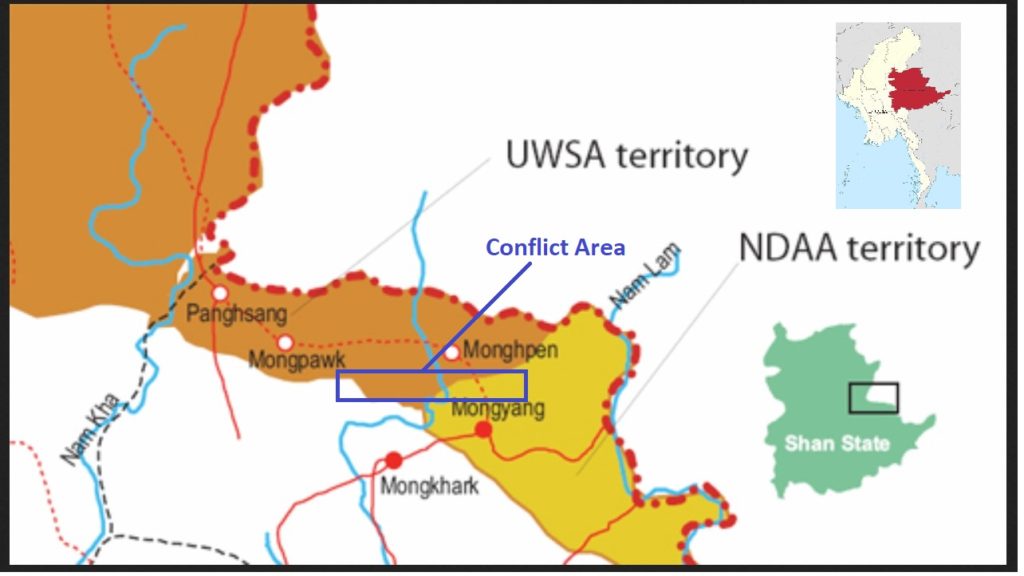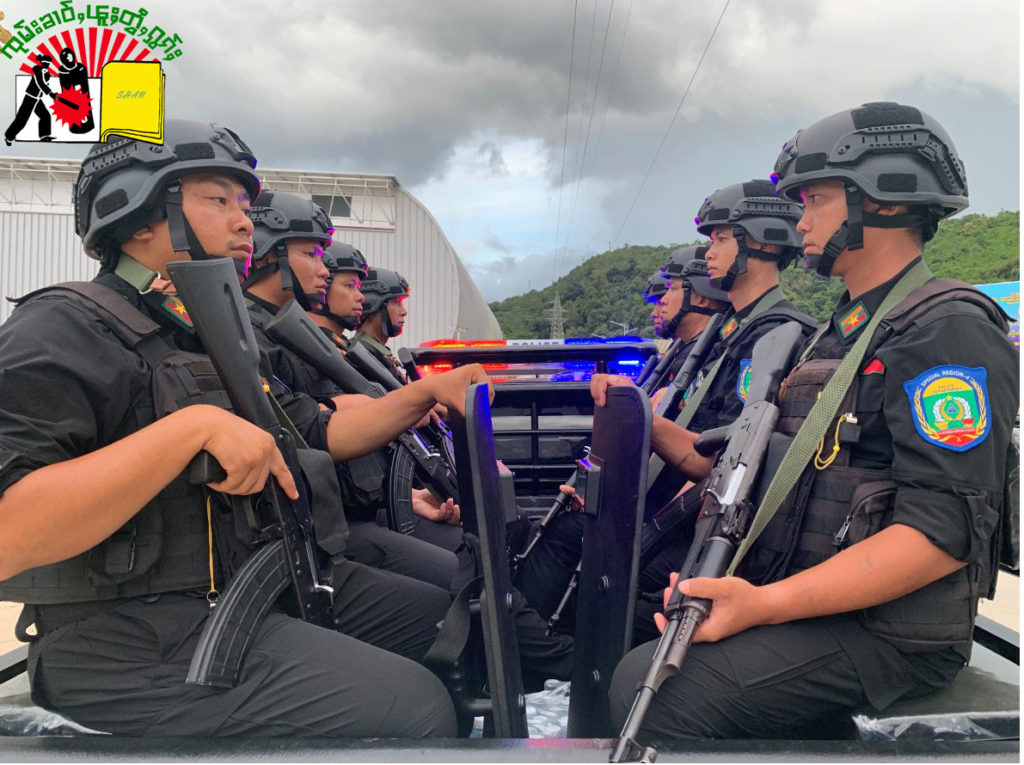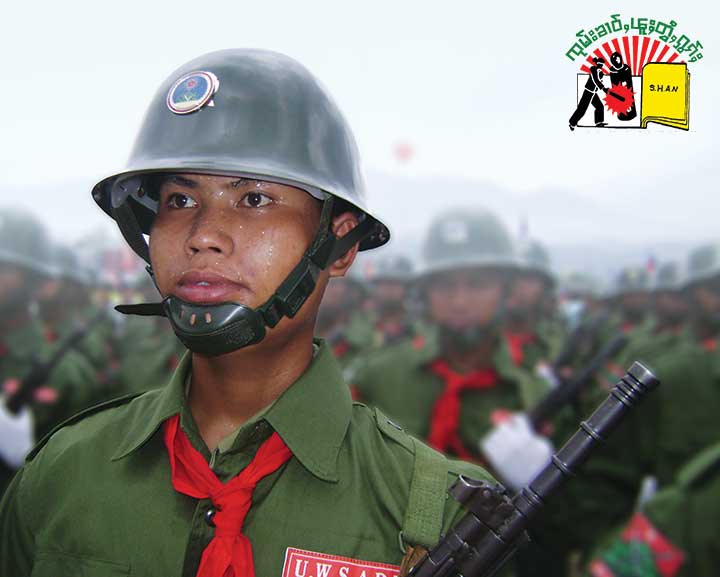Tensions are high between the Burma Army, the United State Wa Army (UWSA) and the National Democratic Alliance Army/Eastern Shan State (NDAA/ESS), also known as “the Mong La group,” over territorial control in northern Kengtung district, eastern Shan State.

The territorial boundary between the UWSA and Mong La group lies in Mong Khark and Mong Yang townships, north of Kengtung. The UWSA controls the western parts of these townships, while the eastern parts are controlled by the Mong La group. The Burma Army, or Tatmadaw, controls the towns of Mong Khark and Mong Yang.
Since late 2019, military tension has erupted between the Burma Army and the UWSA, and between the UWSA and the Mong La group. These problems remain unresolved, leaving the situation in this eastern Shan State-China border region extremely volatile.
The problems will be analyzed by looking first at the military and political relations between the UWSA and the Mong La group, and then at relations between the UWSA and the Burma Army.
Founding of UWSA and NDAA/ESS (Mong La group)
The UWSA and Mong La group have been military and political allies since the establishment of the Wa’s Special Region #2 and Mong La’s Special Region #4. They were both formerly under the Communist Party of Burma (CPB), from 1968 to 1989.
In 1989, Peng Jiasheng’s Kokang group split from the CPB, forming the Myanmar National Democratic Alliance Army (MNDAA), which signed a ceasefire with the Burmese regime. The regime granted the MNDAA control of Kongyan and Laogai, which became Special Region #1
The Wa and Mong La followed the Kokang in splitting away from the CPB. The Wa split away on April 17, 1989, and Mong La on April 19, 1989. They then signed ceasefires with the military regime, brokered by intelligence chief General Khin Nyunt. The New Democratic Army-Kachin (NDA-K) led by Zahkung Ting Ying (now a Border Guard Force) followed suit. These groups, the UWSA, Mong La (NDAA-ESS), Kokang (MNDAA) and NDA-K together founded the People’s Democratic Front (PDF) in 1989.
After the setting up of Special Region #1 by the Kokang, the Wa were allowed to set up Special Region #2, and the Shan State Army (based at Hseng Kaew) set up Special Region #3. The Mong La group, led by Sao Sai Leun, made a ceasefire with the Burmese government on June 30, 1989 and was allowed to establish Special Region #4, with their headquarters at Mong La on the China border – hence their name.
From that time on, the UWSA and Mong La groups enjoyed close cooperation. In 2008, the Burmese military government adopted a new constitution, beginning a process of token democratic transition, and pressed the armed groups to reform into Home Guard Forces (militia) and Border Guard Forces (BGF), under Burma Army control.
This caused several armed groups to split into factions. The Shan State Progress Party/Shan State Army (SSPP/SSA) led by Sao Loi Mao agreed to become Home Guard Forces (militia), while their Brigade #1 led by Sao Pang Fah resisted this. On April 24, 2009, the SSPP/SSA was reformed under Sao Pang Fah, and the headquarters was moved to its present day location at Wan Hai. The Kokang MNDAA similarly split in 2009: Bai Xuoqian’s group became a Border Guard Force, while Peng Jiasheng’s group went underground, and continues armed struggle together with the Northern Alliance against the Burma Army till today.
The NDA-K all followed the Burma Army’s proposal to become a Border Guard Force.
Long-standing cooperation between the Wa and Mong La
In 2009, when the Wa and Mong La groups came under military pressure from the Burmese regime to transform into Border Guard Forces, the two forces cooperated militarily to defend their territories against Burma Army troops deployed close to their borders.

UWSA , Wa Soldier
The UWSA deployed hundreds of troops to Mong Yu, Mong Yawng and Nam Parn, between Mong La and Burma Army-controlled areas. Even though the UWSA’s Pang Sang headquarters supplied funds and salaries for these troops, the Mong La group also provided rations and funds.
At that time, the UWSA clearly considered Mong La as their close allies, and Mong La welcomed the Wa troops stationed around their territories.
From allies to adversaries
Suddenly and without warning, on September 28, 2016, about 1,000 UWSA troops from several battalions advanced upon and seized five Mong La military outposts.
The troops manning the outposts were caught unawares in their sleep, waking to find the UWSA troops pointing guns at them and demanding they lay down their arms. The outposts seized were: Kho Soong (High bridge gate), Wan Nawng Hook, Loi Kio Hsai, Pang Mark Phai gate, and the Mawn Sarm Soom mountain base.
This was a rude shock for the Mong La group, who had fully trusted their allies. From that time on, all Mong La youth over 18, both male and female, have had to undergo military training, to be ready to defend their territory at any time.

After this expansion of UWSA troops into Mong La territory, the Burmese government and military shut down the Taping bridge on the main road between Kengtung and Mong La. They said the bridge would remain closed until the Wa withdrew their troops. Since that time, no travelers between Kengtung and Mong La have been allowed across the Taping bridge until today.
Citizens holding Burmese ID cards can only travel to Mong La from Kengtung using alternative routes via Mong Yawng, Mong Yu and Nam Parn, or via Mong Khark, Mong Yang and Sulue.
It was not until 2017, before the UWSA hosted the conference of armed groups in Pang Sang where the Federal Political Negotiation and Consultative Committee (FPNCC) was formed, that Wa troops were withdrawn from some of the outposts they had seized in 2016 – likely as a result of Chinese pressure. However, the Wa did not withdraw all their troops, and some remain stationed at Mawn Sarm Soom mountain base until the present.
The rift between the two groups persists. Even though their leaders regularly meet and dine together, tensions continue to simmer beneath the surface.
Chinese mediation fails to resolve tensions
On October 23, 2019, the Burma Army Tactical Command based at Mong Khark, led by Colonel. Thurein Htun, set up a military checkpoint along the Mong Khark-Mong Noong-Mong Ngaen road, which obstructed the movement of UWSA troops.
The UWSA’s Brigade 468 responded by attacking and destroying the checkpoint. They captured the Burmese troops stationed there, but released them on October 27, 2019, allowing them to return to their base.
On October 28, 2019, with tensions still high between the UWSA and Burma Army, Wa troops were deployed eastwards to set up a new outpost close to a Mong La outpost, north of Wan Yang Lao. They remain there until today.
On November 8, 2019, a group of about six UWSA troops passed across a sugar cane farm, and began ascending towards a hilltop Mong La base at Yang Lao, east of Mong Yang town. The Mong La troops chased them away with gunfire, wounding one Wa soldier in his abdomen. The UWSA troops retreated without returning fire.
On November 12, 2019, Pao Ai Parn, the UWSA Brigade 468 Commander met with authorities in Mong La to discuss the problem. Pao Ai Parn said: “First, people are allowed to travel freely, so why did you not allow us to pass? Second, this planet is for human beings, so why you did not allow our people to pass? Third, we are allies, and we can position our bases where your outposts are. Fourth, are you preparing your troops to fight with us?”
To these questions, the Mong La authorities replied: “First, it is the duty of our officials to check and interrogate travellers. Second, it is not permitted to travel freely with arms, because we have already demarcated our territory. Third, as we have our liaison office, we must inform each other to request permission to go anywhere. Fourth, we are training our troops to be ready for battle, not against any particular group. However, if anyone invades our land and challenges us, we will sacrifice our lives to protect ourselves and drive the intruders from our lands.”
At this time, UWSA troops from Battalion 68 and Brigade 468, led by Pao Ai Parn, intruded into Mong La territory, occupying farmlands of six villages — Wan Narn, Wan Weing Luong, Wan Yang Lao, Wan Pha Dam, Wan Mark Ka and Wan Huay Yang Hoke. The villagers therefore submitted a five point request to the UWSA troops.
They stated first that they did not agree with the setting up of UWSA camps on their land. Second, as villagers had to farm, the UWSA troops had to withdraw within 3 days. Third, all the troops’ equipment must also be withdrawn within 3 days. Fourth, if they did not withdraw on December 21, 2019, the villagers would push them out. Fifth, they asked the UWSA to consider long-term good relations and withdraw all their troops from Kawng Kharn, Yang Lao, Hin Moan and Upper Wan Mark Ka.
The UWSA troops refused to comply with these requests, so on December 21, the villagers again went to press their demands, but without success.
On December 24, 2019, and on January 10, 2020, the Chinese Special Envoy for Asian Affairs Mr. Sun Guoxiang came to the disputed area, and invited the Mong La authorities and Pao Ai Parn, the UWSA Brigade 468 commander, to meet with him. He urged the UWSA to withdraw their troops, but to no avail. He warned them that if fighting broke out, blame would fall on the group that started fighting. He said China just wanted development along their border, not gunfire.
Escalating tensions between the Burma Army and UWSA
The recent tensions between the Burma Army and UWSA are just the latest in a series of confrontations that have almost erupted into armed conflict in the UWSA’s 171 southern military region along the Thai border — at least three times. It is alleged that each time the situation was defused by large amounts of money being given by UWSA leaders to the Burma Army commander in chief.
In Mong Khark and Mong Yang townships, even before the latest tensions, the Burmese authorities had been placing travel restrictions not only on Wa troops but on Wa ethnic people holding Burmese ID cards, who were closely interrogated. This is continuing until today.
On November 12, 2019, after the Wa had dismantled the Burma Army checkpoint along the Mong Noong route the previous month and while the UWSA were meeting with the Mong La group, the Burma Army sent in troop reinforcements to Mong Yang and Mong Khark townships. Troops were sent in from five battalions under Military Operations Command 18 in Mong Phyak, together with artillery, tanks and armored trucks. The Triangle Regional Commander in Kengtung oversaw the operation.
In response to the Burma Army deployment, the UWSA also tightened security measures around their areas. In December, three Burmese soldiers sneaked into the UWSA controlled area, losing contact on December 5, 2019. Unconfirmed reports came out on December 18 that the three Burmese soldiers had been captured and killed. The soldiers’ families were distraught, and the Burma Army demanded that the Wa immediately release the Burmese troops, whether dead or alive. However until now there has been no sign of the missing troops.
The UWSA appear to fear that the Burma Army may attack them from the rear, by crossing via the jungle from Mong La to Mong Pauk.
Meanwhile, government spokesperson U Zaw Htay has said: “The Wa do not have a plan to secede from the Union and the government might consider granting their desire (to establish a Wa State).”
The UWSA’s aim is to control the entire eastern Shan State, including Kengtung, as Wa territory and set up a Wa State under Naypyitaw’s direct control. But according to a Shan analyst, the Burmese government is simply offering to allow a Wa State in order to fuel conflict between the UWSA and Mong La, and if fighting breaks out, the Burma Army will likely support Mong La against the Wa.
Whatever the case, it is certain that China does not want fighting along its borders, and the Burma Army is obliged to listen to its powerful ally, who is backing them against Western pressure on human rights issues.
The question is, how long will China be able to control the volatile situation between the UWSA, Mong La and Burma Army, and keep the guns silent along its borders?
Written by Khun Sang Mu , Translate by Hseng Kung Mong





